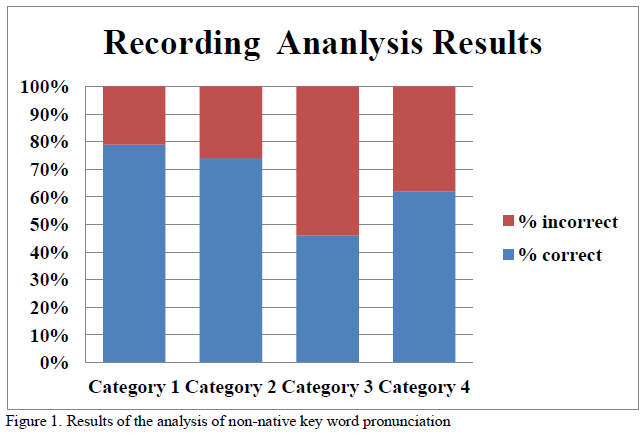Vitalijs Sadovskis and Dr. Grant Lundberg, Department of German Studies and Slavic Languages
The major goal of this research was to determine through both theoretical analysis and practical application which Russian pronunciation difficulties for native English speakers result in a misunderstanding of meaning rather than foreign accent. Therefore, it focused on Russian pronunciation errors which can significantly hinder communication and understanding of speech by those who listen. This research took into account the differences between English and Russian sound inventory, thus indicating not only possible stumbling blocks for any speakers of Russian as a non-native language, but also denoting specific difficulties for those who speak English as their first language. The major stumbling blocks causing alteration of meaning in non-native Russian speech, according to hypothesis of this research, are (1) Russian sounds that don’t have their counterparts in the speaker’s native language, (2) Russian stress, (3) Russian intonation, and (4) the relationship between spelling and pronunciation:
- Non-native speakers often struggle with the pronunciation of the sounds which are absent in their native language. Since language sounds are the minimal units responsible for word meaning, mispronunciation of a sound can cause alteration in word meaning. It is expected that those Russian sounds which do not have their English counterparts would be substituted for the closest English analogues available, thus sometimes affecting the meaning of speech.
- Russian stress can fall on any syllable and is usually not marked in script. Therefore, in any given text it is not possible to distinguish between two words with the same spelling and different stress locus without addressing interpretation of their contextual environment. If non-native speakers of Russian misinterpret the context or are simply unaware of the stress locus, they can unintentionally alter their speech meaning.
- Though Russian is not a tone based language, in rare cases the only indicator of meaning in otherwise identical Russian words is intonation. The rise of the tone in one word and the fall of the tone in the other are the principal ways to differentiate between such words. Therefore, using inappropriate intonation can affect speech meaning and cause a miscommunication.
- A number of Russian words that have identical spelling and stress locus are pronounced differently and do not have the same meaning. Neither native nor non-native speakers can define which word is used in a text based purely on the way it is written. Like in categories (2) and (3), the immediate context is the only way to identify the word.
The first step of the research process was to form four sets of word pairs for each of the four categories described above. Every word in a pair had a different meaning and also matched principal conditions of the appropriate category. After forming all four sets of pairs, a number of sentence samples containing these words were created. Forty keywords were selected and combined in twenty pairs to match one of the four categories. Based on these keywords, forty-two sample sentences were written. The purpose of the samples was to evaluate the ability of native English speakers to pronounce the key words correctly. The next step of the research was to test the hypothesis. In order to do so, we tested a group of 16 native speakers of English enrolled in RUSS 323 (Russian Phonology and Morphology). The vast majority in this group are advanced Russian speakers and returned missionaries who served their missions in Russian speaking countries. Each person was asked to read the samples out loud. Their voices were recorded and the key words in their speech were clipped out via Audacity 2.0.2 software. The key words were played to three native Russian speakers to see if they understood the words as it should have been in context.
The English speakers recruited for the study read the key words in categories 1, 2, 3 and 4 with 79%, 74%, 46% and 62% accuracy, respectively (displayed in figure 1). Therefore, the data indicates that the students were generally proficient in the skills of pronouncing Russian sounds that do not appear in English (category 1) and of properly pronouncing words with the same spelling and different stress locus (category 2). Therefore, contrary to our hypothesis, it was discovered that for advanced speakers, words in categories 1 and 2 are not major stumbling blocks which cause alteration of meaning. It is likely that the deviation from our hypothesis is due to the students’ advanced proficiency level because of their significant speaking experience in country and/or in the classroom. Our hypothesis that categories 1 and 2 may be major stumbling blocks in communication with native Russian speakers may hold true for non-advanced speakers. In accordance with our hypothesis, pronunciation of words in categories 3 and 4 presented major difficulties for native English speakers in accurately conveying the meaning of the sample text. The students’ most significant difficulty was to properly pronounce the tone-based key words in category 3 (46% accuracy). Tone-based words occur rarely and only in very colloquial speech, which is not often the topic of classroom instruction. It appears that the majority of students’ in country speaking experience was not sufficient enough to compensate for lack of classroom instruction in familiarization with colloquial tone based words. The key words in category 4 also presented a major challenge (62% accuracy) for the English speakers. One letter in Russian, e, found in the key words in category 4, can represent two different basic sounds, one which occurs more regularly, while the second less frequently. Students tended to read this letter as though it represented the more common sound, even in cases when it represented the less common sound.
It is reasonable to conclude that the frequency of occurrences of language features in the categories determined the accuracy rates of the students. It is fair to hypothesize that this principle of frequency may be applicable to other language features which are not the subject of this study.

